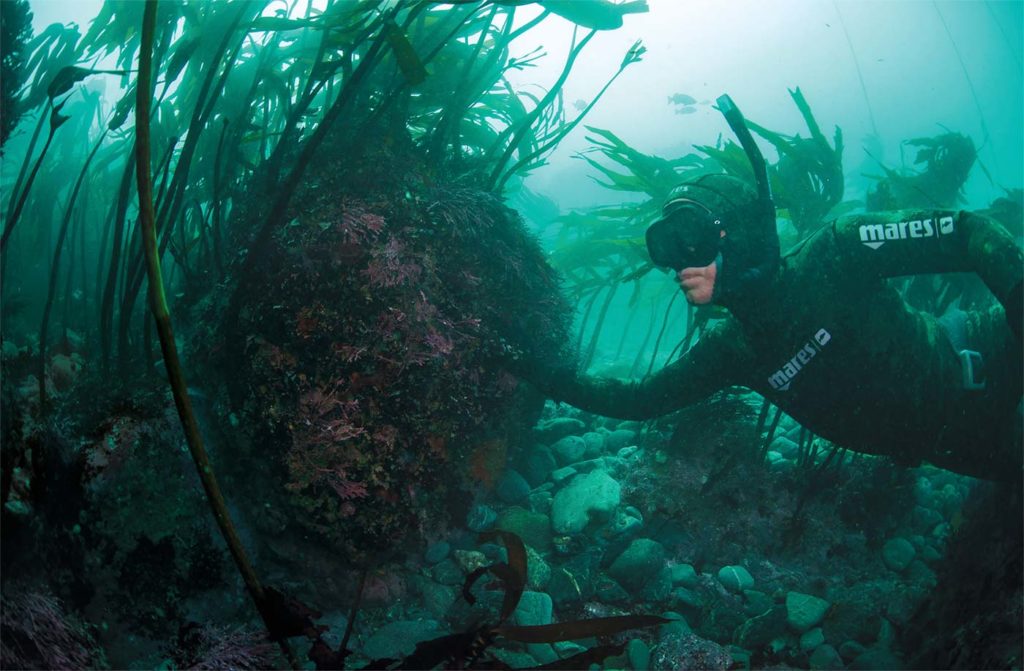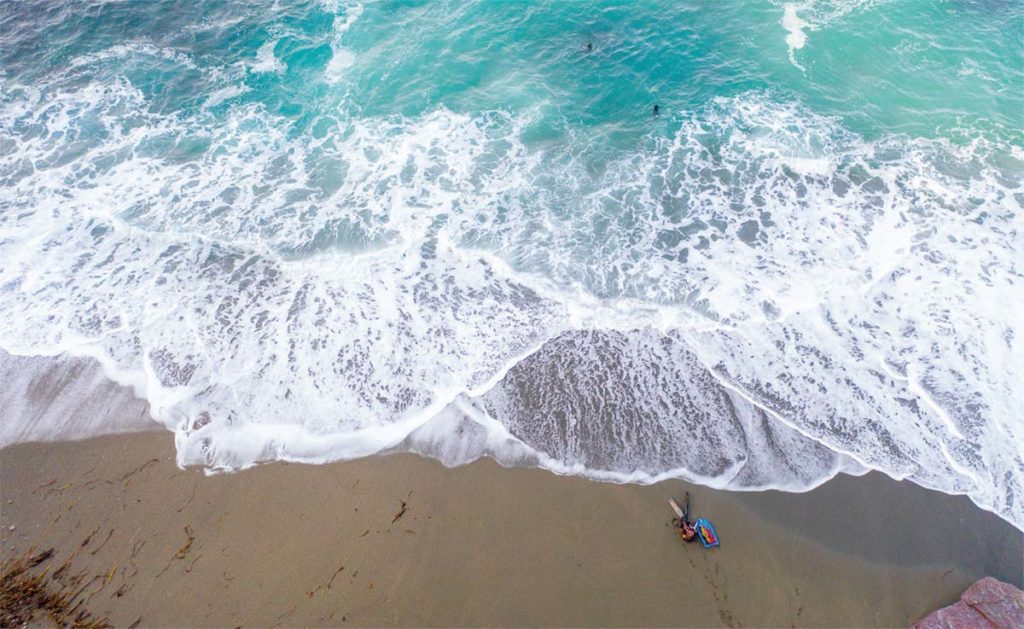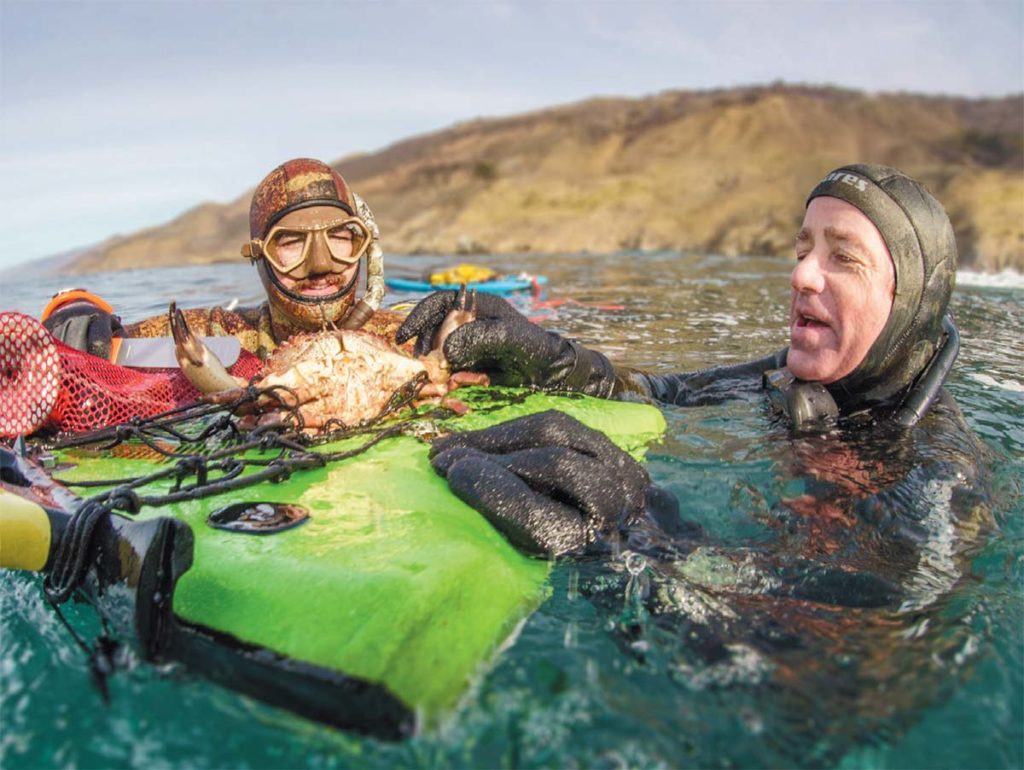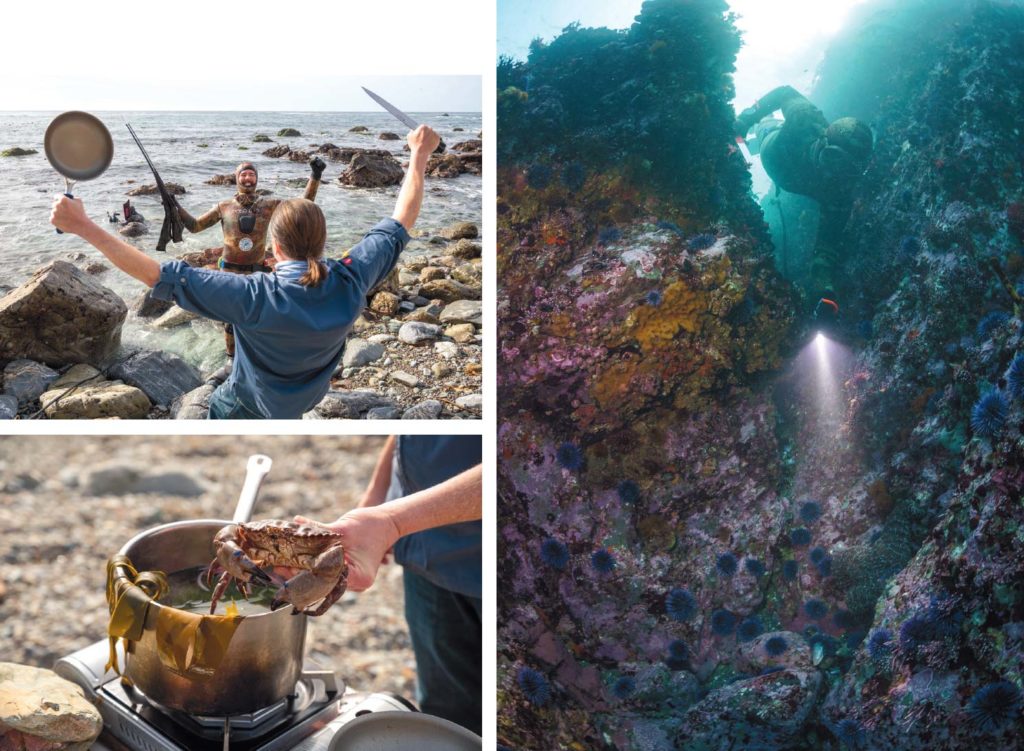PHOTOGRAPHY BY GLEN MCDOWELL AND JOE PLATKO

Fin + Forage aims to change perceptions of spearfishing and takes our intrepid reporter on a freediving adventure in Big Sur
The “catch” involves pre-dawn driving, satellite maps, a drone, pro photographers, a rappel down 250 feet of cliff, nearly two miles of openocean swimming and a dozen spearfishing descents.
The “cook” has its own nuances. Lunch entails swimming ashore for a socially distant, pop-up, chef-driven situation on the sand, made possible by the morning harvest, and schlepping of burners, pots, pans, wine, spirits and a wet bar down a switchback so goodies like brown-butter limpet and a Gray Whale Gin martini can materialize.
In other words, “catch-and-cook” sounds simple enough. Not so much.
So it goes with the startup behind this adventure, Monterey Baybased Fin + Forage, which has a penchant for going “full send,” to borrow from founder and professional spearfisherman Eric Keener’s technical terminology. Full send is also his default setting, and has been since he was an orphaned San Jose biker with a gift for stunts and extralegal business dealings.
Today’s expedition fits into Fin + Forage’s larger goal of spotlighting the best of the booming sport of spearfishing, while educating audiences on sustainable harvesting and cheffing. “Spearo” culture provides sizzle, but it’s the food that provides sustenance.
“Few things in life have more power to unite than food,” reads Fin + Forage’s mission. “Yet for those of us privileged with food security, the act of obtaining, preparing, and eating food too often becomes an afterthought.”
Not today.
“The social media reputation of spearfishing is big fish or bikinis and booty. We wanted to combat that.”
BREATHING UNEASY
Before any repels or swells, I must fit into a specialized snugger-thanspandex wetsuit at Bamboo Reef Dive Center. I duck into the human flytrap, claustrophobia activated, and it’s immediately clear there’s no way I’ll fit. A Bamboo staffer promptly makes it rain cold lube on the interior. Now my head and arms squirt through with a satisfying plorrrp.
On to safety prep. Giray Armağan, a Turkish engineer who can dive 163 feet deep into the cold, murky, dark depths of the Pacific on a single breath, is familiar with freedive beginners after years as an instructor. He covers how he’ll communicate underwater (with a guttural “grouper call” named after the big fish) and where to point a spear gun (away from divers). He is most intense about one rule: Don’t look where you’re going.
That would be natural on a descent, he acknowledges, but it risks hyperextending one’s throat and spitting blood at the surface. Keep it tucked.
“Like you’re holding a grapefruit under your chin,” he says, emphasizing vertical peripheral vision. “You’ll know when you get to the bottom just fine.”
He adds this: “We’ll be offshore in deep Big Sur, miles from any cell reception.”
Don’t look where you’re going rings ironic because Fin + Forage is very intentional about where it’s heading. With the help of a facilitator friend, Keener and partners Andrew Miller and Ryan Gentry conducted several hours-long design sprints, generating scores of pages on branding, voice and visions for a king tide of Fin + Forage content, policy work and collaborations extending over a 20-year timeline.
“That planning seemed like a good thing to do,” Keener says. “The social media reputation of spearfishing is big fish or bikinis and booty. We wanted to combat that.”
Priorities include elevating awareness about overfishing (and overall ocean health) and lowering waste with head-to-tail cooking techniques that maximize bones, heads and organs.
“You fillet enough fish and you realize so much is going to trash,” says Miller, an environmental scientist who studied at Hopkins Marine Station, “and it really seemed like a lot of the talk in the spearfishing community was about three main species when there was a lot out there that was edible and no one seemed to be exploring.”
The planning sessions began in May 2020. As of today F + F has assembled an Avengers-like lineup of divers, photographers, videographers and journalists to contribute to its online platform. Published content includes videos, product reviews, spearfishing tales, original marine biology content, rich imagery and tutorials on things from paring your fresh catch to ranking top dive lights. Dozens of recipes like sweet salt and pepper calamari and coastal foraged cioppino proliferate, along with live chef Q&As, international spearfishermen profiles and a podcast.
“It should be community, adventure and what you do with the fish,” Keener says. “If you’re not focused on that, you’re missing out on a huge portion of the sport.”
So the plan is in place. But to borrow from an old adage, you can’t really know where you’re going until you know where you have been.


BACK TO THE BEGINNING
To reach a remote clutch of refugees hiding from genocidal troops in the jungles of Southeast Asia, Keener and his roommate Rev. Charles Meyers had to do some things.
Recruited to help the Free Burma Rangers by their minister as single, fit and adventurous, they were ultimately smuggled across international borders and rivers, under blankets and ballast, risking long foreign jail time to trek 100 miles with packs loaded with 70 pounds of food and medical supplies. Four days of walking—for which they trained months—led to a camp where they ate vines, beetles and frogs while teaching English and other skills to help the persecuted ethnic minority document wrongdoing and escape hiding to find jobs. (They’re legally bound to shield more details about whom they protected.)
There are other head-spinning parts to Keener’s story: how a broken home pushed him to a nomadic life by 12. How an unfulfilled existence of motorcycles, heroin, sex and street crime (“After my childhood, I was constantly seeking to belong,” he says) moved him to one of faith and service (“a different type of belonging, real belonging”). How his kindasorta first date with his now-wife led them to build a raft out of plastic 55-gallon drums and lumber, and sail it down Utah’s Green River.
In each place adventure did good. The Free Burma Rangers, who committed their lives to death-defying rescues, taught him respect for— and perspective on—personal agency. The rafting trip raised money for a young girl fighting rare bone cancer.
When his freediving hobby blossomed into a semi-pro obsession— and his skill set and social media following grew—Keener got to thinking: How can I leverage my platform?
TAKING THE PLUNGE
“Most of the spearfishing videos are kill kill kill,” Keener says. “It may be a beautiful dive, but it’s a kill video. We want to focus on other things.” He rattles off what he calls the stages of hunting: Kill something. Kill a lot of somethings. Kill the biggest something. Kill what you need. Kill only what you need, mindfully, with the least impact possible.
The day’s catch and cook expedition fits into the fifth category. After we meet on a turnout along the deep South Coast, we lube down, suit up and assemble spearguns and catch bags on modified boogie board backpacks. Then the four of us descend one by one over stubborn brush and shifting soil to the pocket beach below, on a line tied to a highway reflector. Photographer Glen McDowell tracks our progress with his drone, taking photos and alerting us when the line is free.
Once we’ve poked around for some jade in the sand, we’re kicking our long fins through a sizable set of waves. The morning light on the turquoise water seems summoned by fairy mermaids, and more magic awaits below.
Visibility unlocks 40 feet of clarity, a rarity, and through it a bloom of pink pyrosomes—little free-floating, tube-shaped colonial tunicates— drifts before our facemasks.
My rentals perform a fraction as well as the squad’s gorgeous custom fins sponsored by DIVR, but mine make for more exercise. Partnerships, it turns out, are an F + F strongsuit, and include industry titans like O.M.E.R. and Ocean Guardian. Our underwater photog, Joe Platko, is both a volunteer partner and a magnet for more collaborations, furnishing stunning images that sponsors love.
The swim south takes us through swaying kelp groves and over remote reefs abundant with a Dr. Seussian assortment of sealife—blue rockfish, olive rockfish, black-and-yellow rockfish, several types of perch and an occasional California sheephead. Huge scallops, as stubborn as they are meaty, succumb to Armağan’s crowbar-like scallop knife.
Keener, Armağan and Platko all find a meditative resting breath at the surface and then drop as far as 45 feet to scout out low-lying crevices. Fishing in earnest will wait until we’re closer to coming ashore, to prevent the fish drag from slowing our swim or turbo-aging in the sun on top of the boards. I simulate their moves, duck dive and keep my chin tucked until I reach the ocean floor. My senses are unanimous: A mere 25 feet deep feels a world away.
Keener says a good freediver takes what’s coming and goes with it. “You’re not in control, but you can still be effective,” he says. “I love the surge. I don’t try to fight it. I know what’s behind me, I let the surge come and line up the shot in front of me. That might be hard for people who want to be in control.”
We surface and keep kicking. After another hour and a mile, the wait-to-hunt plan has grown dubious. Visibility is trending toward milky. Swells are rising, enough that when I swim ahead, the team loses track, and Keener thinks I might be subletting Davy Jones’ locker.
We do have a rock crab that was nice enough to appear unsheltered atop a shelf of reef, plus the collection of scallops. While I gather seaweed and search for sea urchins—Platko’s advice to descend along a strand of bull kelp helps me conserve air spent kicking—Keener worries we might come back to shore fish free.
On his penultimate drop he deploys an “aspetto” technique, scratching rocks to attract curious fish, then waiting, breath held, at depth, hoping one will emerge from the murk. A big blue rockfish obliges and Keener’s shot is true. Soon the four of us are waiting for a window between the bigger and bigger breakers to beach ourselves awkwardly on the stony shore.

PACIFIC TO PLATE
The haul fills the stylish cutting boards provided by yet another partner, The Rustic Craftsman (aka Lindsey Krezeczowski), and plates from local textile savant, Nicole Pilar. We add mussels we gather from the shallows.
“Yes, there’s a challenge to the ocean: How deep and how long you can dive,” Keener says. “But it doesn’t have to stop there. Cooking is hard.” That thought primed Gentry, Keener and Charlie Robinton to arrange 2019’s Catch and Cook Competition at Monterey Bay Kayaks on Del Monte Beach. Unlike most fishing tournaments, the goal would not be catching the biggest fish but cooking the best dish.
They expected a dozen entrants. Thirty-eight showed for the 6am safety check and returned by the 1pm deadline with a prepared plate. Divers’ families joined a Save Our Shores trash-collection competition that earned an 8-year-old a $500 prize package. Local businesses contributed $15,000 in awards and raffle items. Celebrated Monterey chefs Danny Abbruzzese (Portola Hotel, By The Bay BBQ, Seaside Seafood & Market), Tom Snyder (Seventh & Dolores) and Colin Moody (The Club at Pasadera) judged.
“I didn’t know who the hell they were, but I wanted to check it out,” Moody says. “When I saw what was going on—no bravado, more about family, local identity and conservation, the whole package—I thought it was badass.”
Dishes got surprisingly complex, like the second-place crispy skin grassy rockfish with dirty rice made with 100% wild-harvested ingredients. Moody was so impressed with Shane Wescott’s third place rockfish, wrapped in puff pastry and baked with bricks in the sand, he almost offered him a job.
The event’s organic success inspired Fin + Forage itself and our own version of it on this winter day. Moody, now Fin + Forage’s head chef, is among those who greet us on the South Coast shore. He surveys the spoils and springs into action.
“It’s fun when you don’t know what’s coming,” he says with a big smile.
Moody cleans and gently sautés everything from the crab to the mussels. He thinly slices a big limpet, an abalone cousin. He sears it and some scallops in brown butter. Between the stock and the fruits de mer, Moody uses every bit of the seafood, layering the tender fish and invertebrates over sourdough crumbs, and garnishing with spot prawn shell powder and sea lettuce-infused potato foam. Dish number two is blue rock cod-scallop ceviche with grilled citrus and avocado served with crispy fish skin and sea lettuce chicharrons. (See recipe)
While this is happening, sommelier and local event coordinator Toby Rowland-Jones, F + F’s house mixologist, pairs Galante Viognier, Dawn’s Dream Rosé from the Santa Lucia Highlands and his own cocktail creations with the food. Not a bad Pacific-to-plate picnic.
Moody has been around the area—and in and out of the bay exploring and surfing—for decades. He’s seen some things, but never anything quite like the Fin + Forage menu.
“As chefs we get some foraged things,” he says, “but not stuff like this.” The next Catch and Cook Competition will expand well beyond Monterey Bay, happening via YouTube, and launching as soon as early March, with a three-month deadline. Categories will range from Best Meal to Best Story to People’s Choice, with celebrity judges like Outdoor Chef Life’s Taku and spearfishing cinematography star David Ochoa joining local judges like Moody.
After lunch, he and I stand on the beach and watch the persisting swell obscure whatever might be on the horizon.
“We know what we want to do and what we want to be a part of,” Moody says. “It’s about holding on to that and being ready with your skills and experience. The path ahead may not be clear, but our intentions can be.”
That thought feels right on time. The uncertainty surrounding coronavirus on land and the ills we’ve caused our oceans can be unnerving, but only seem to inspire and intensify Fin + Forage’s push for engagement and education. It also makes navigating the onrushing future that much more important—and adventurous. A full send is only appropriate.
Rockfish-Scallop Ceviche with Crispy Skin and Sea Lettuce Chicharrons
Courtesy Colin Moody, The Club at Pasadera
About the author
Mark C. Anderson, EMB's managing editor and "Found Treasures" columnist, welcomes responsible and irresponsible feedback. Correspond via mark@ediblemontereybay.com.
- Mark C. Andersonhttps://www.ediblemontereybay.com/author/markcanderson/
- Mark C. Andersonhttps://www.ediblemontereybay.com/author/markcanderson/
- Mark C. Andersonhttps://www.ediblemontereybay.com/author/markcanderson/
- Mark C. Andersonhttps://www.ediblemontereybay.com/author/markcanderson/



